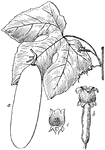
Leaf Indentations
An illustration of a fossil of a toothed fern. Ferns are vascular plants differing from the more primitive…

Fox Sedge and Fringed Sedge
3, The Fox Sedge (Carex vulpinoidea) and 4, the Fringed Sedge (Carex crinita).
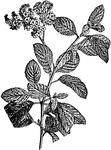
Heliotropium
The heliotropes (Heliotropium) is a genus of plants in the family Boraginaceae with 250 to 300 species.…

Hemp
An illustration of the common hemp plant. Hemp (from Old English hænep) is the common name for…
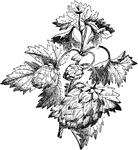
Hop
An illustration of the hop plant. Humulus, (hop) is a small genus of flowering plants, native to the…

Resurrection Plant
The fertile plant of the Resurrection Plant (Selaginella lepidophylla), a spikemoss which lives in deserts.

Hedera colchica
Hedera (English name ivy, plural ivies) is a genus of 15 species of climbing or ground-creeping evergreen…
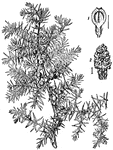
Juniper
An illustration of a juniper branch, vertical section of fruit (1), and male catkin (2). Junipers are…

Septicidal Dehiscence
"Septicidal Dehiscence. v, valves; d, dissepiments; c, axis. In botany, noting a mode of dehiscence…

Poppy Septa
"Fruit of Poppy, cut transversely to show the 12 septa (S) with the seeds." -Whitney, 1911

Poppy Septa
"Diagram of fruit of Poppy, cut transversely to show the 12 septa (S) with the seeds omitted." -Whitney,…

Dodder
An illustration of Dodder including: 1, flower removed from; 2, Calyx; Ovary cut acrossed; 4, fruit…
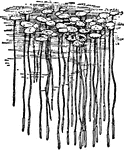
Duckweed
An illustration of duckweed. Duckweed is an important food source for waterfowl and are eaten by humans…

Duckweed
An illustration of duckweed. Duckweed is an important food source for waterfowl and are eaten by humans…

Duckweed Inflorescence
An illustration of duckweed inflorescence containing two male flowers each of one stamen and a female…

Sundew
The Sundews (Drosera rotundifolia) comprise one of the largest genera of carnivorous plants, with over…
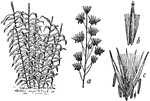
Giant Reed
"Bamboo-reed (Arundo donax). a, panicle; b, flowering scale, clothed with silky hairs; c, spikelet."…
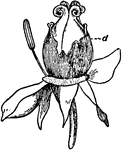
Peony Bud
Paeonia) is the only genus in the flowering plant family Paeoniaceae. They are native to Asia, southern…

Sedum
Sedum is the large stonecrop genus of the Crassulaceae, representing about 400 species of leaf succulents,…
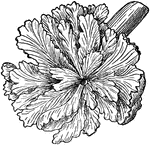
Wood Rose
"Wood-rose, a remarkable vegetable excrescence, resembling a flower with radiating corrugated petals…
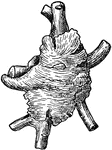
Wood Rose
"Wood-rose, a remarkable vegetable excrescence, resembling a flower with radiating corrugated petals…

Mural Frieze-like Decoration from the Temple of Esneh
They are generally of smaller dimensions in the interior, so that the walls or columns of the same chamber…

Ornament at the foot of the wall from the Great Temple at Philæ
They are generally of smaller dimensions in the interior, so that the walls or columns of the same chamber…

Gentiana
Gentianaceae, or the Gentian family, is a family of flowering plants of 87 genera and over 1500 species.
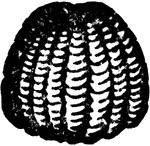
Owl Moth
The owl moth is a moth whose larvae are known to feed on a wide array of plants including a range of…

Cyperus
An illustration of the partial inflorescence of a cyperus plant, spikelet of the same (left), and the…

Carex
Carex is a genus of plants in the family Cyperaceae, commonly known as sedges (although other, related…
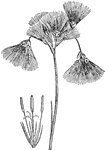
Cottongrass
Eriophorum (Cottongrass, Cotton-grass or Cottonsedge) is a genus of about 25 species of flowering plants…
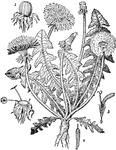
Dandelion
Taraxacum is a large genus of flowering plants in the family Asteraceae. They are native to Europe,…

Stitchwort
Stellaria is a genus of about 90-120 species flowering plants in the family Caryophyllaceae, with a…
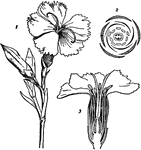
Dianthus
Dianthus is a genus of about 300 species of flowering plants in the family Caryophyllaceae, native mainly…
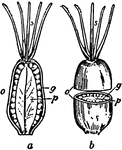
Mouse-ear Chickweed
An illustration of the pistil, female reproductive part of the flower, from the mouse-ear chickweed.…

Propagation by Cuttings
Plant propagation is the process of artificially or naturally distributing plants. Pictured here is…
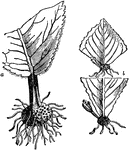
Leaf Cuttings
Plant propagation is the process of artificially or naturally distributing plants. Pictured here is…

Fumitory
Fumaria is a genus of about fifty annual herbaceous flowering plants in the family Fumariaceae, native…

Fumitory (Side-view)
An illustration of the side-view of the fumitory flower Fumaria is a genus of about fifty annual herbaceous…

Fumitory Flower (Longitudinal Section)
An illustration of a longitudinal section of the fumitory flower. Fumaria is a genus of about fifty…
Fumitory Flower Anther
An illustration of a fumitory flower anther. Fumaria is a genus of about fifty annual herbaceous flowering…

Myrtle
The Myrtle (Myrtus) is a genus of one or two species of flowering plants in the family Myrtaceae, native…

Carrot Flower
An illustration of the inflorescence of the carrot plant. An inflorescence is a group or cluster of…
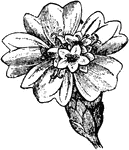
Inflorescence of Asteraceae
An illustration of a inflorescence of a asteraceae. The family Asteraceae or Compositae (known as the…

Disk-floret of Asteraceae
An illustration of a disk-floret of a asteraceae. The family Asteraceae or Compositae (known as the…

Disk-floret of Asteraceae
An illustration of a disk-floret of a asteraceae. The family Asteraceae or Compositae (known as the…
Gynaeceum of Asteraceae
An illustration of a Gynaeceum of a asteraceae. The family Asteraceae or Compositae (known as the aster,…
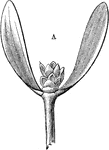
Mistletoe Flower
An illustration of the flower of the mistletoe plant. Mistletoe is the common name for a group of hemi-parasitic…
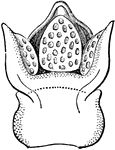
Mistletoe Staminate
An illustration of one staminate flower in section, magnified twelve times. Mistletoe is the common…
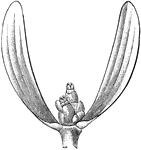
Pistillate Flowers of Mistletoe
An illustration of pistillate flowers of mistletoe. Mistletoe is the common name for a group of hemi-parasitic…
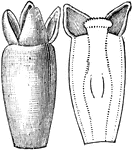
One Pistillate Flower of Mistletoe
An illustration of one pistillate flower of mistletoe. Mistletoe is the common name for a group of hemi-parasitic…

Mistletoe Attached to Host Plant
An illustration of a mistletoe plant attached to the host plant. Mistletoe is the common name for a…

Sedge
An illustration of the female flower of the sedge plant. Carex is a genus of plants in the family Cyperaceae,…
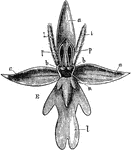
Fly Orchid
Fly orchid (Ophrys insectifera) is a plant of the family Orchidaceae, a native of the British Isles…
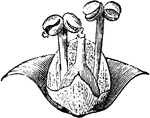
Lemnaoideae
Lemnaceae is a family of flowering plants, also known as the duckweed family, as it contains the duckweeds…
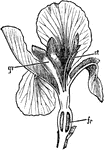
Iris
Iris is a genus of between 200-300 species of flowering plants with showy flowers. It takes its name…

Turk's Cap Lily
Lilium martagon (Martagon or Turk's cap lily) is a species of lily. It has a widespread native region…
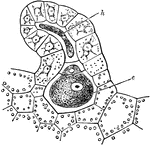
Archegonium of Bracken
An illustration of the archegonium of bracken. An archegonium (pl: archegonia), is a multicellular structure…

Bell Heather
The magnified flower of the Bell Heather (Erica cinerea) is a plant in the Ericaceae family of heaths.

Club Moss
Lycopodiopsida is a class of plants often loosely grouped as the fern allies, and includes the clubmosses.…
